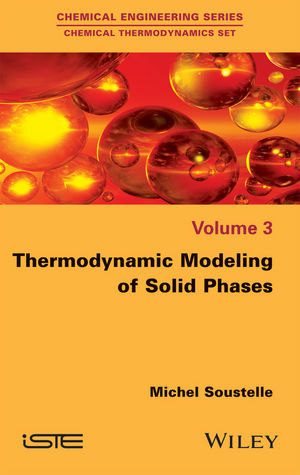
Thermodynamic Modeling of Solid Phases
ISTE Ltd and John Wiley & Sons Inc (Verlag)
978-1-84821-866-6 (ISBN)
Michel SOUSTELLE is a chemical engineer and Emeritus Professor at Ecole des Mines de Saint-Etienne in France. He taught chemical kinetics from postgraduate to Master degree level while also carrying out research in this topic.
PREFACE ix
NOTATIONS AND SYMBOLS xiii
CHAPTER 1. PURE CRYSTALLINE SOLIDS 1
1.1. Characteristic values of a solid 1
1.2. Effect of stress and Young’s modulus 2
1.3. Microscopic description of crystalline solids 4
1.4. Partition function of vibration of a solid 5
1.4.1. Einstein’s single-frequency model 5
1.4.2. Debye’s frequency distribution model 6
1.4.3. Models with more complex frequency distributions 9
1.5. Description of atomic solids 10
1.5.1. Canonical partition function of an atomic solid 10
1.5.2. Helmholtz energy and internal energy of an atomic solid 11
1.6. Description of molecular solids 13
1.6.1. Partition function of molecular crystals 13
1.6.2. Thermodynamic functions of molecular solids 14
1.7. Description of an ionic solid 15
1.7.1. Crosslink energy of an ionic solid 15
1.7.2. Born/Haber cycle 22
1.7.3. Vibrational partition function and internal energy of an ionic solid 23
1.8. Description of a metallic solid 26
1.8.1. Sommerfeld’s electron perfect gas model 27
1.8.2. The metallic bond and band theory 37
1.9. Molar specific heat capacities of crystalline solids 46
1.9.1. Contribution of the vibrational energy to the specific heat capacity at constant volume 46
1.9.2. Specific heat capacity of an atomic solid at constant volume 50
1.9.3. Specific heat capacity of a molecularor ionic-solid at constant volume 54
1.9.4. Conclusion as to the specific heat capacity of a crystalline solid 54
1.10. Thermal expansion of solids 55
1.10.1. Expansion coefficients 55
1.10.2. Origin of thermal expansion in solids 58
1.10.3. Quantum treatment of thermal expansion. Grüneisen parameter 62
1.10.4. Expansion coefficient of metals 68
CHAPTER 2. SOLID SOLUTIONS 71
2.1. Families of solid solutions 71
2.1.1. Substitutional solid solutions 72
2.1.2. Insertion solid solution 75
2.2. Order in solid solutions 82
2.2.1. Short-distance order 83
2.2.2. Long-distance order 87
2.3. Thermodynamic models of solid solutions 94
2.3.1. Determination of the Gibbs energy of mixing 94
2.3.2. The microscopic model of the perfect solution 100
2.3.3. Microscopic model of strictly-regular solutions 102
2.3.4. Microscopic model of the ideal dilute solution 104
2.3.5. Fowler and Guggenheim’s quasi-chemical model of the solution 106
2.4. Thermodynamic study of the degree of order of an alloy 111
2.4.1. Hypotheses of the model: configuration energy 112
2.4.2. Expression of the configuration partition function 113
2.4.3. The Gorsky, Bragg and Williams model 114
2.4.4. The quasi-chemical model 120
2.4.5. Comparison of the models against experimental results 127
2.5. Determination of the activity of a component of a solid solution 132
2.5.1. Methods common to solid solutions and liquid solutions 134
2.5.2. Methods specific to solid solutions 140
CHAPTER 3. NON-STOICHIOMETRY IN SOLIDS 147
3.1. Structure elements of a solid 147
3.1.1. Definition 148
3.1.2. Symbolic representation of structure elements 149
3.1.3. Building unit of a solid 151
3.1.4. Description and composition of a solid 151
3.2. Quasi-chemical reactions in solids 153
3.2.1. Definition and characteristics of a quasi-chemical reaction between structure elements 153
3.2.2. Homogeneous quasi-chemical reactions in the solid phase 156
3.2.3. Inter-phase reactions 158
3.3. Equilibrium states between structure elements in solids 158
3.4. Thermodynamics of structure elements in unary solids 159
3.4.1. Structure elements of a unary solid 159
3.4.2. Global equilibrium of an isolated crystal – influence of temperature 162
3.5. Thermodynamics of structure elements in stoichiometric binary solids 165
3.5.1. Symmetrical disorders in stoichiometric binary solids 166
3.5.2. Asymmetrical disorders in stoichiometric binary solids167
3.6. Thermodynamics of structure elements in non-stoichiometric binary solids 169
3.6.1. Deviations from stoichiometry and point defects 169
3.6.2. The predominant defect method – the Wagner classification 171
3.6.3. Equilibrium of a Wagner solid with one of its gaseous elements 174
3.6.4. General equilibrium of a non-stoichiometric binary solid with one of its gaseous elements 175
3.7. Representation of complex solids – example of metal oxy-hydroxides 180
3.7.1. The pseudo-binary approximation 180
3.7.2. The predominant-defect generalization 180
3.8. Determination of the equilibrium constants of the reactions involving structure elements 181
3.8.1. Recap on calculating the equilibrium constants using statistical thermodynamics 182
3.8.2. Examination of the pre-exponential term in the quasi-chemical equilibrium constants 184
3.8.3. Determination of the internal energy of transformation of quasi-chemical reactions 187
CHAPTER 4. SOLID SOLUTIONS AND STRUCTURE ELEMENTS 195
4.1. Ionic solid solutions 195
4.1.1. Introduction of foreign elements into stoichiometric binary solids 197
4.1.2. Influence of foreign elements introduced into a non-stoichiometric binary solid 200
4.2. Thermodynamics of equilibria between water vapor and saline hydrates: non-stoichiometric hydrates 204
4.2.1. Experimental demonstration of non-stoichiometry of a hydrate 204
4.2.2. Equilibria between stoichiometric hydrates 207
4.2.3. Equilibrium reactions in non-stoichiometric hydrates 207
4.2.4. The limits of the domains of divariance 213
APPENDICES 217
APPENDIX 1. THE LAGRANGE MULTIPLIER METHOD 219
APPENDIX 2. SOLVING SCHRÖDINGER’S EQUATION 223
BIBLIOGRAPHY 227
INDEX 231
| Verlagsort | London |
|---|---|
| Sprache | englisch |
| Maße | 165 x 241 mm |
| Gewicht | 553 g |
| Themenwelt | Naturwissenschaften ► Chemie ► Physikalische Chemie |
| Naturwissenschaften ► Physik / Astronomie ► Thermodynamik | |
| ISBN-10 | 1-84821-866-4 / 1848218664 |
| ISBN-13 | 978-1-84821-866-6 / 9781848218666 |
| Zustand | Neuware |
| Haben Sie eine Frage zum Produkt? |
aus dem Bereich


